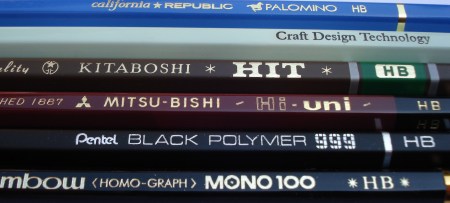
One of pencil talk‘s most popular subjects has been Japanese pencils. Made to extremely high standards, these pencils are the preferred working tools of many artists, drafters, and other professionals around the globe. Thanks to the world wide web, it’s now possible for those of us outside Japan to acquire these first rate writing implements.
In this review, we will compare and contrast the HB versions of six Japanese pencils:
California Republic Palomino
Craft Design Technology item 17
Kita Boshi Hit No. 9900
Mitsubishi Hi-uni
Pentel Black Polymer 999
Tombow Mono 100
We will look at appearance, grip, sharpening, erasure, fastness, and writing capabilities, and attempt an overall assessment by assigning points in each category to the pencils.
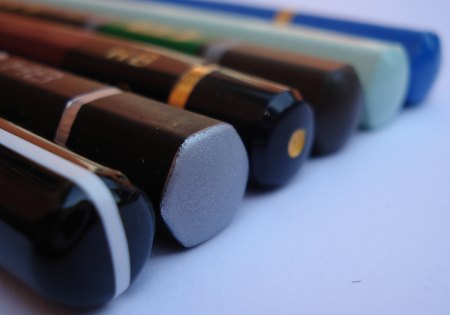
The pencils.
1. The California Republic Palomino is made in Japan for California Cedar Products. Introduced in 2005 and sold primarily through an eBay store, the manufacturer is unknown.
CalCedar states that they are “the world’s leading supplier of wooden slats for the production of wood-cased pencils.” So they are a supplier to the pencil industry, and may very well have provided the wood used in all six of these pencils.
The product home page is here.
2. item 17 is the highly generic name used by Craft Design Technology. The pencil is made by Pentel for CDT, and is part of a large line of office supplies provided by a number of manufacturers, including Pentel, Sun-Star, Lion, Sanwa, Yamato, Zeba, and Takeo. Tyler Brule is among their creative team.
CDT has a website here. Note: the website uses extensive flash animation, window resizing, and popups.
3. The Hit 9900 is made by Kita Boshi. Though they specialize in children’s pencils, the Hit is a first rate pencil, and worthy of inclusion in this list.
Kita Boshi have a website here. Take a look at their interesting headquarters building, which they call “Pencil House”.
4. The Mitsubishi Hi-uni is made by the Mitsubishi Pencil Company – no relation to the Mitsubishi Motor Company. They were established in 1887, and trade on the Tokyo Stock Exchange. The Hi Uni, along with the Mono 100, has long been considered to be at the pinnacle of pencil making. Of course, our challenge today is to see if this reputation is deserved.
Product page here.
5. The Black Polymer 999 is make by Pentel. A heavyweight in the mechanical pencil world, I cannot find too much online about their woodcase manufacturing operations. The continued availability of this pencil, and their production of CDT’s pencil, indicate that Pentel is still active in this area.
6. The Mono 100 is the offering from Tombow. It has many adherents in the animation field who feel it is the world’s best pencil. Tombow was founded in 1913, and launched the Mono 100 in 1967.
Tombow’s website includes a lot of English language content for those of us who don’t speak Japanese, and includes some interesting print and television ads for their local market.
Here is their pencil page.
There are other pencils I wish could be added to this review – The Pentel 999? (999 alpha) was Pentel’s premiere offering, but appears to have been withdrawn from the market. I haven’t been able to locate any. The Colleen Pencil Company folded a few years earlier, but was greatly admired for their quality. More information is available at this site devoted to Colleen pencils. The Japanese pencil industry website also lists other manufacturers, but most appear to be in the novelty market.
Appearance (20 points)
We’ll evaluate the pencils themselves, but I thought I’d start by mentioning the packaging. The Mono 100 and Hi-uni come in sturdy, reusable cases that will actually protect the pencils. If you’ve never seen these, they are an immense surprise. The CDT and Pentel pencils come in standard but attractive pencil-matching cardboard boxes. The Hit 9900 comes in a generic unlabeled white cardboard box. The Palomino used to ship in a plastic box of six, though it now also has a wooden box option, and possibly others.
I will cut right to the verdict here – the opinion of everyone who has seen these pencils (including myself) is that the CDT pencil is an immediate standout – clear, clean design with minimal black text, and a fantastic original choice of colour.
Next to the CDT pencil, I give a nod to the Palomino, again for clear, clean design with minimal text. It gets second because the colour (it comes in both blue and red-orange) isn’t quite as original as the CDT pencil, nor is the gold colour text. It also has a painted ring, which emulates the embedded gold colour rings of the Mono 100 and Hi-Uni. However, I think it is a distraction, and the paint wears off over time.
All six pencils are made to very high standards – rich, highly finished deep varnishes, with no paint spilling over the unfinished end.
Bar codes may be a business necessity, but the Palomino, item 17, and Hit 9900 pencils avoid them – perhaps because they aren’t available as open stock at retail. Regular readers of the blog know that we don’t like bar codes on pencils. They interfere with the pencil’s look, and the impression on the pencil casing can interfere with the grip.
The Hi-uni and Mono 100 have an additional distinguishing feature – signature caps. In each case, a gold colour ring (I’m not sure of the material) is embedded near the crown. The Mono 100 has a white stripe traversing the cap, and the Hi-Uni has an embedded yellow dot in the cap. I do think this pride in the product is great.
The Hit 9900 and High Polymer 999 are distinguised by matte finishes, while the other four are glossy.
All six pencils are made to very high standards, and there is no doubt that each one exudes quality. In the end, the amount of text and the presence of barcodes on the brand name pencils reduces their scores.
| Appearance | |
| Pencil | Score |
| California Republic Palomino | 17 |
| Craft Design Technology item 17 | 19 |
| Kita Boshi Hit 9900 | 15 |
| Mitsubishi Hi-uni | 14 |
| Pentel Black Polymer 999 | 16 |
| Tombow Mono 100 | 14 |
Grip (10 points)
The decision by Pentel and Kita-Boshi to eschew a glossy finish for a matte finish may cause the pencils to look a little less shiny on display, but the better grip is a real potential benefit to users.
The nod in this category goes to the Hit 9900 due to the matte finish and no bar code. The 999 doesn’t get full benefit of the matte finish due to a stamped bar code, and I found myself rotating the pencil to avoid touching that part of the pencil. The Palomino and item 17 are close seconds due to their consistent finishes, which allow consistent grips no matter how the pencil is rotated.
| Grip | |
| Pencil | Score |
| California Republic Palomino | 8 |
| Craft Design Technology item 17 | 8 |
| Kita Boshi Hit 9900 | 9 |
| Mitsubishi Hi-uni | 7 |
| Pentel Black Polymer 999 | 7 |
| Tombow Mono 100 | 8 |
Sharpening (10 points)
This evaluation was truly a challenge. There are many types of sharpeners and sharpening technology available. It may be that most users of these high-end pencils are in animation studios, and use electric sharpeners. I use handheld sharpeners, and though it better that I stick to them.
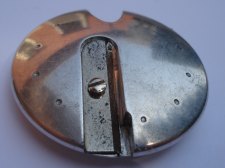
I started with a KUM Inox, which is representative of the type of sharpener I tend to like – compact, yet heavy enough to get a reasonable grip. But it has a very minimal sleeve for guiding the sharpener to the blade, and it didn’t seem to produce results that would be photo-worthy. I also considered that a Japanese sharpener would be appropriate, but the only ones I have are made by Tombow, and I thought they might subtly favour the precise dimensions of the Tombow pencil.

One sharpener I have that does work consistently well, perhaps because it does have more a significant sleeve for guiding the pencil, is the Faber-Castell UFO. The problem was that the blade was somewhat used, and it seemed unfair (though perhaps realistic) to use a dull blade. Enter the Laywine’s Special Order department, who were able to supply me with a replacement blade.
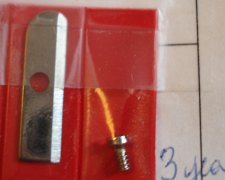
We are testing the pencil wood and lead, and the expectation is that the wood will be smoothly shaved away. We hope the point to be sharp and centered, but after taking pencil photos for a while, I’m quite aware that pencils rarely sharpen “perfectly”.
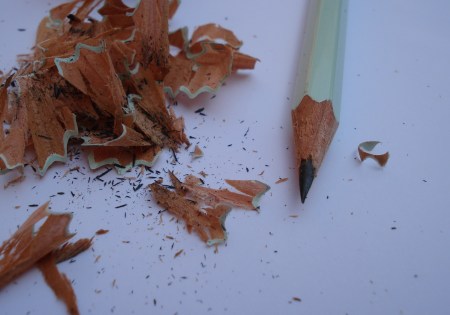
The wood – there are two standouts here – the Hi-uni and Mono 100 produce very red and rich cedar shavings. Is it the result of a different cedar variety or some sort of treatment?

The toughest sharpening was with the CDT pencil, while the Palomino was sharpened in an almost continuous spiral shaving. Yet the range was narrow, and all did well.
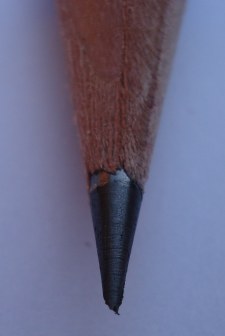
As to the point produced – the Hi-Uni is just perfect. I’ll draw on some past experience here. When it seems your hand is unsteady, or a sharpener blade is dull – try the same sharpener on a Hi-Uni, and it will usually produce a result that makes you wonder about what’s wrong with other pencils.
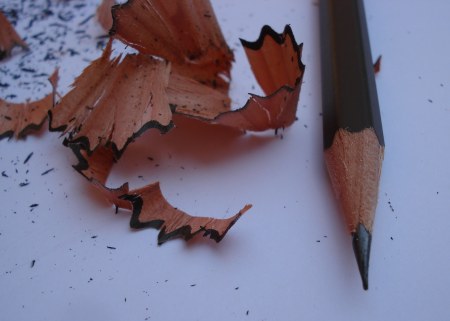
All the other pencils sharpened well, yet slightly excessive amounts of wood were removed. I’m giving them all the same score, an an exceptional ’10’ to the Hi-uni.
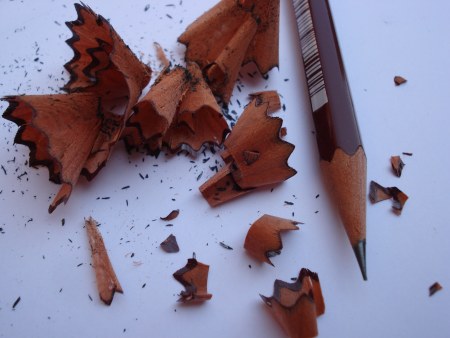
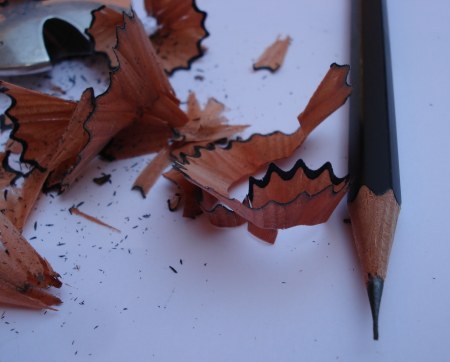
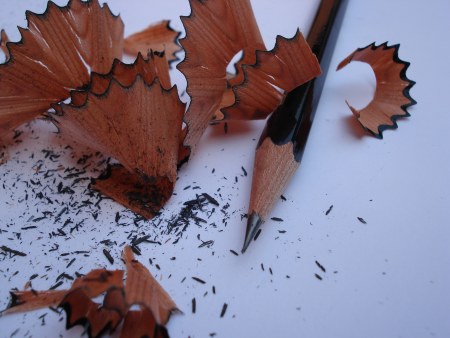
| Sharpening | |
| Pencil | Score |
| California Republic Palomino | 8 |
| Craft Design Technology item 17 | 8 |
| Kita Boshi Hit 9900 | 8 |
| Mitsubishi Hi-uni | 10 |
| Pentel Black Polymer 999 | 8 |
| Tombow Mono 100 | 8 |
To be continued

A couple of years ago I communicated with Tombow Japan and was advised that from about December 2005 the Mono-100 was replaced with the Mono-Professional which sports a cream end rather than the Mono-100’s “black with white stripe”. That advice was confirmed bypencil things at the time.
I have followed the link to the Tombow pencil page in the main thread and cannot find the Professional. Was I misinformed about the demise of the Mono-100?
I hope so as having tried the Professional I found it to be inferior both as to quality of lead and wood.
Further to my earlier comment I just checked the 2008 catalogue available on the Tombow Japan website and it clearly shows the Mono-100 as available http://www.tombow.com/products/catalogue/sougou/r/00001_76bm.htm
The black sleek design of those japan pencils makes me wish they were available more localy around my area. I would buy 1,000 of each so if they stopped manufacturing them I could still have a secret stash =D
The Tombow Mono 100 has not been discontinued!
Tombow USA of Lawrenceville, GA have stopped directly carrying it. But the pencil was “replaced” only in a marketing sense. Tombow USA is promoting the second-tier Tombow Mono as their replacement. The USA packaging for the Mono has the words “Professional Drawing Pencil,” but the pencil identifies itself, and is known elsewhere as the “Mono”.
There is at least one firm that shows photos of the Mono 100 at their website, but ships the Mono, so be careful when ordering this pencil.
I am much interested in how pencil lovers out side Japan feel about Japanese pencils. Generally, I think, those made in Japanese are darker and softer than those in Europe or America. Also thicker in dimension. Probably these come from difference of criteria.
Pentel, Mitsubishi, and Tombow are three great wood-cased pencil manufacturers. We can buy many kinds at any stationery shops in Japan. Especially Mitsubishi No.9000 and No.9800 are long sellers. The latter is still on sale and have a great popularity.
http://ciely.blog5.fc2.com/blog-entry-17.html
Recently, however, those designed for Mark Sheet(Mark sense in English) have been used more.
Anyway I am a Castel fanatic, for its colouring, long-life-lead and smoothness. I am looking forward to your continued report.
Stephen, you had me at the words “Japanese pencils”, but beyond that, with your graceful clear prose and methodical analysis, you prove that you are a born scientist. You just keep outdoing yourself and it is a positive joy to read your blog. I breathlessly await part two of the latest installment. This is better than the movies, better than the TV by far.
I thought that was a UFO, but I’ve never seen a photo of the business side of it such as you show here. To your question regarding the “red and rich” cedar shavings produced by the Hi-Uni and Mono 100, I have recently read that the coloration is artificial unless the slats come from Eastern Red Cedar. Probably I found this little nugget of information elsewhere here or got it from Petroski’s book. Also, indeed, “what is wrong with other pencils”? Very occasionally I achieve stellar sharpening results with my Palominos in either a Prismacolor or Kum longpoint sharpener. Thanks for the tour-de-pencil, can’t wait to see the rest of it.
Great posting, look forward to part 2.
Thank you for the comments.
Johnny, wanting to buy a thousand of your favorite pencils echos many a past comment here, though people usually seem to settle on a gross (144) or three for their stash.
Griffith, thanks for your insights.
There are two large North American pencil makers left in the market, so it isn’t difficult to get a sense of their products.
The European situation is less familiar to me – there are a few major companies that extensively export – Faber-Castell, Staedtler, Lyra, Koh-I-Noor, but also some quite large national pencil manufacturers that do not, and I have no sense of what those non-exporting manufacturers offer.
Barrel, thank you for the generous praise. I am glad you enjoy the website, though I am very far from being a scientist.
What a treat! Keep up the fine work, penciladmin!
Thank you very much admin. I think that you may well be on the way to filling the huge void left by the demise of “Pencil Revolution”
Thank you also for the info on the Mono-100. IMHO the best all round range of pencils available. Although the California Republic Palominos have also grabbed my attention.
Wow. Wow. Wow. Frankly, I haven’t known that California Republic pencils are not made in California. LOL. I have to check my whole CR collections tomorrow.
About Tombow MONO and MONO100 pencils, here’s my poor tlanslation of the words on this paper, which was inside the plastic case of MONO100.
“Thank you for buying MONO 100. MONO100 is the pencil whose feature has been extremely increased. There’s 10 billion molecules per 1 cube millimeter. It is one of the world best pencil that overcome MONO, which has 8 billion molecules per 1 cube millimeter and was acclaimed by many people.”
So MONO100 is the improved version of MONO. Hence I don’t think MONO can replace MONO100.
At the HB grade, Palomino smash like Hulk all who dare challenge its equine name!
Atta boy Matt. Ride that Palomino! yee-hah!
PencilAdmin – FYI – There is a long history of a rather extensive sub-contracting network of small producers in Japan. As with the Palomino, Pentel does not manufacture any pencils themselves. This is certainly the case also with the Craft Design Item 17 pencil as well, it’s been produced by sub contractors for the marketing entity. Some of the companies specialize in just the production of the raw pencils, some just do finishing, some do everything. The various sub-contractors usually also have ties to some of the larger producers like Mitsubishi or Tombow to make some pencils for them as well, though I expect both the Hi-Uni and the Mono are produced exclusively at the Mitsubishi and Tombow facilities.
This reminds me of Kotobuki‘s role in the market of mechanical pencils.
Please excuse my request if it is inappropriate.
I am a teacher of Visual Commincation at Hampton Park Secondary College, Victoria, Australia and wanted to know if you would consider donating a set of drawing pencils and/or coloured pencils to the students in my year 12 class. I would like them to have every opportunity of success in their exams and it would be so encouraging for them to have excellent equipment. These sorts of products are generally out of their reach.There are 13 in my class, but I have managed to save 4 Derwent sets for this purpose already. I would really appreciate your contribution. I will send a photo of the class with their sets and an appreciation certificate,if you are able to assist.
Thank you so much for your time.
Lyne
PS Anything that you could manage for these students would be greatly appreciated (they are great kids and I want to help them as much as I can)
School email:
facey.lyne.l@edumail.vic.gov.au
Each year we have a group of students from Japan visit our college, for one week and they always find their stay most enlightening and educational
What’s the difference between the Mitsubishi 9800 2B and the Mitsubishi Hi Uni 2B?
Of the pencils shown in this comparison I have the Mitsubishi Hi Uni, the Tombow Mono 100 and the California Republic Palomino. In grades HB to 2B the Hi Uni and Mono 10 are both excellent. The Mono 100 seems to leave a little less dust on the page. I have not tried the Palomino yet. The less expensive Mitsubishi Uni and 9800 pencils are also very good as are the Tombow Mono Js. Earlier this year I added a box of the Palomino Blackwing Pearl pencils to my Blackwing 602 and regular Blackwings. I also bought an unsharpened original Ebnerhard Faber Blackwing 602. My plan is to sharpen it for the first time in 2014. I still have many pencils I haven’t used yet and that I have accumulated over about the last 18 months. Last week a pack of four Mitsubishi 9800 B pencils arrived from a seller in Japan. The cost was just under US$5.00 including shipping. This year I found some oddball pencils with the name Kuelox with a umlaut over the u. I think they were from China and they have the same color scheme as the Staedtler Mars Lumograph. The ones I got are in B and 2B hardnesses. Both the graphite and the wood seem softer than those of the Staedtlers. Another odd pencil is the Mitsubishi Uni three sided pencils with the Super Mario (Nintendo) design on them. I would like to try the three pencils in your comparison which I have not yet used. If they are not easy to find I might just ask a friend in Tokyo to track them down for me.
Hi respected Gentleman,
I am from India and i and whole world like Japan for its good quality products, I wish to start a new business for Pencils in India and need support from u make ur Pencils in India on MAKE IN INDIA account. Can u help me?